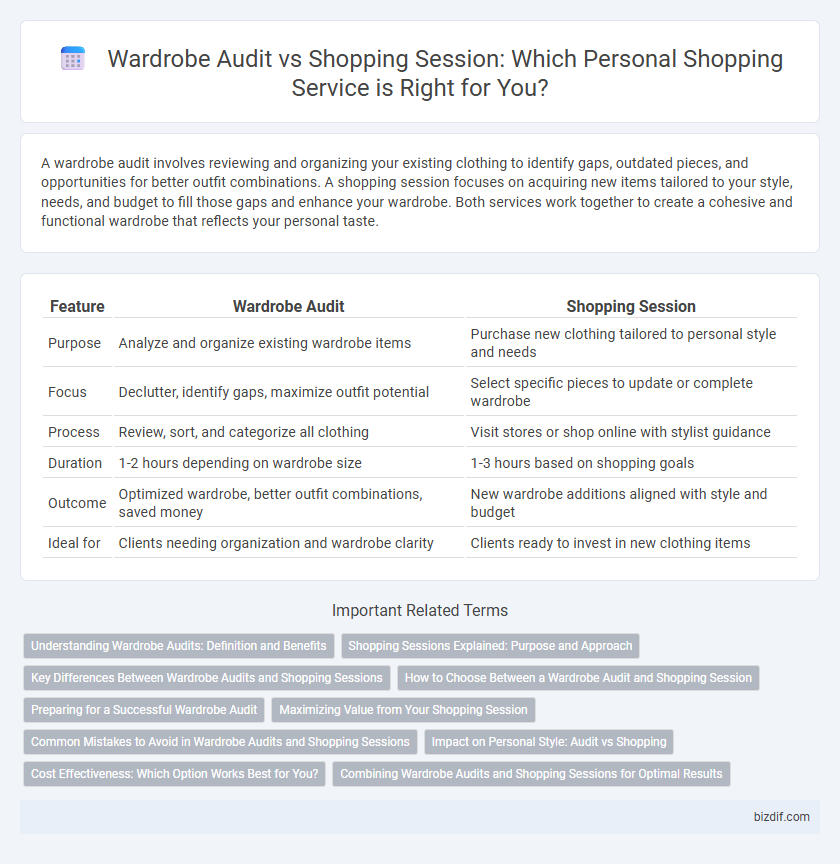A wardrobe audit involves reviewing and organizing your existing clothing to identify gaps, outdated pieces, and opportunities for better outfit combinations. A shopping session focuses on acquiring new items tailored to your style, needs, and budget to fill those gaps and enhance your wardrobe. Both services work together to create a cohesive and functional wardrobe that reflects your personal taste.
Table of Comparison
| Feature | Wardrobe Audit | Shopping Session |
|---|---|---|
| Purpose | Analyze and organize existing wardrobe items | Purchase new clothing tailored to personal style and needs |
| Focus | Declutter, identify gaps, maximize outfit potential | Select specific pieces to update or complete wardrobe |
| Process | Review, sort, and categorize all clothing | Visit stores or shop online with stylist guidance |
| Duration | 1-2 hours depending on wardrobe size | 1-3 hours based on shopping goals |
| Outcome | Optimized wardrobe, better outfit combinations, saved money | New wardrobe additions aligned with style and budget |
| Ideal for | Clients needing organization and wardrobe clarity | Clients ready to invest in new clothing items |
Understanding Wardrobe Audits: Definition and Benefits
Wardrobe audits involve a thorough evaluation of clothing items to identify gaps, outdated pieces, and styling opportunities, optimizing wardrobe functionality. This process enhances decision-making and reduces impulse purchases, leading to a more curated and versatile closet. Understanding wardrobe audits helps prioritize thoughtful shopping sessions tailored to actual needs and personal style.
Shopping Sessions Explained: Purpose and Approach
Shopping sessions focus on acquiring specific items aligned with your style goals and current wardrobe gaps, ensuring purposeful purchases. Personalized shopping experts analyze preferences, budget, and lifestyle to curate selections that enhance outfit versatility and cohesion. This targeted approach minimizes impulse buys and maximizes wardrobe functionality.
Key Differences Between Wardrobe Audits and Shopping Sessions
Wardrobe audits involve a comprehensive evaluation of existing clothing to identify gaps, outdated pieces, and styling opportunities, optimizing current assets before new purchases. Shopping sessions focus on acquiring specific items based on style goals, fit, and budget, targeting fresh additions to enhance or update the wardrobe. The key difference lies in wardrobe audits prioritizing assessment and organization, while shopping sessions emphasize intentional buying for wardrobe growth.
How to Choose Between a Wardrobe Audit and Shopping Session
Choosing between a wardrobe audit and a shopping session depends on assessing your current closet's functionality and your style goals. A wardrobe audit helps identify gaps, outdated items, and pieces to keep or donate, maximizing your existing wardrobe's potential. Opt for a shopping session when you need to update key staples or enhance your style with targeted new purchases aligned with your lifestyle needs.
Preparing for a Successful Wardrobe Audit
Preparing for a successful wardrobe audit involves organizing clothes by category, assessing each item's condition, fit, and style relevance to current trends and personal needs. This process identifies gaps and redundancies, enabling informed decisions during a shopping session tailored to complement and enhance the existing wardrobe. Prioritizing quality over quantity ensures that new purchases align with long-term style goals and promote sustainable fashion choices.
Maximizing Value from Your Shopping Session
Wardrobe audits identify gaps and excess in your current clothing collection, creating a targeted shopping list that maximizes value during your shopping session. By pinpointing essential pieces and eliminating duplicates, you ensure each purchase complements your existing wardrobe and enhances overall style cohesion. This strategic approach reduces impulse buys and prioritizes investment in versatile, high-quality items that deliver long-term wardrobe value.
Common Mistakes to Avoid in Wardrobe Audits and Shopping Sessions
Avoid common mistakes in wardrobe audits such as overlooking seasonal pieces and failing to assess garment condition, which can lead to ineffective decluttering and poor shopping decisions. During shopping sessions, prevent impulse buys by setting clear style goals and creating a prioritized shopping list based on the audit findings. Consistently aligning wardrobe audits with targeted shopping sessions ensures a cohesive, functional, and personalized wardrobe.
Impact on Personal Style: Audit vs Shopping
A wardrobe audit enhances personal style by identifying gaps, eliminating outdated pieces, and aligning clothing choices with individual preferences, resulting in a more cohesive and versatile wardrobe. Shopping sessions focus on introducing new items that complement existing styles or fill specific needs, directly influencing outfit options and seasonal trends. Combining both strategies creates a balanced approach, optimizing personal style through thoughtful evaluation and targeted acquisition.
Cost Effectiveness: Which Option Works Best for You?
A wardrobe audit highlights existing clothing pieces, helping identify gaps and avoid unnecessary purchases, making it a cost-effective strategy to maximize your current wardrobe investment. In contrast, a shopping session focuses on acquiring new items tailored to your style and needs, which can be cost-effective if guided by a professional to prevent impulse buys. Choosing between the two depends on your budget and goal--audits save money by optimizing what you own, while shopping sessions require investment but can enhance wardrobe functionality efficiently.
Combining Wardrobe Audits and Shopping Sessions for Optimal Results
Combining wardrobe audits and shopping sessions creates a streamlined personal shopping experience that maximizes closet efficiency and style cohesion. Wardrobe audits identify gaps and outdated items, guiding focused shopping sessions tailored to fill specific needs with versatile, high-quality pieces. This integrated approach ensures a balanced wardrobe that aligns with personal style and lifestyle demands, optimizing investment in clothing.
Wardrobe audit vs Shopping session Infographic

 bizdif.com
bizdif.com